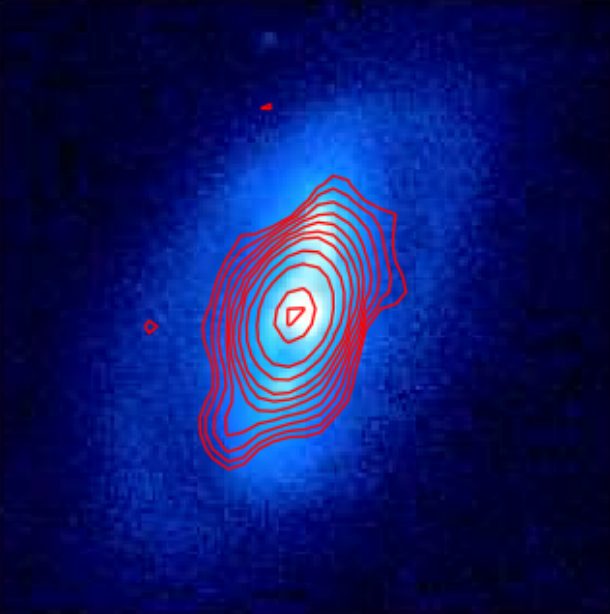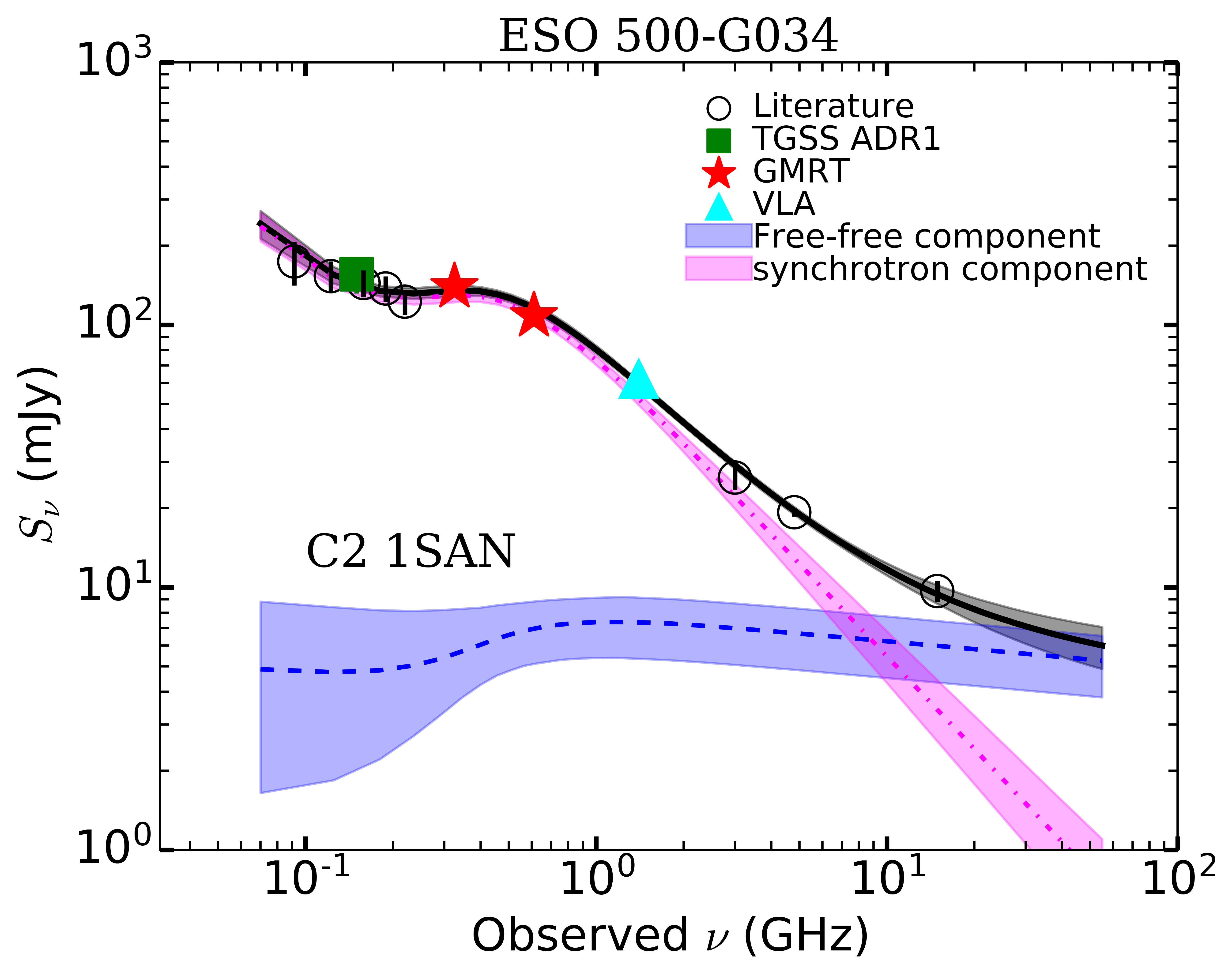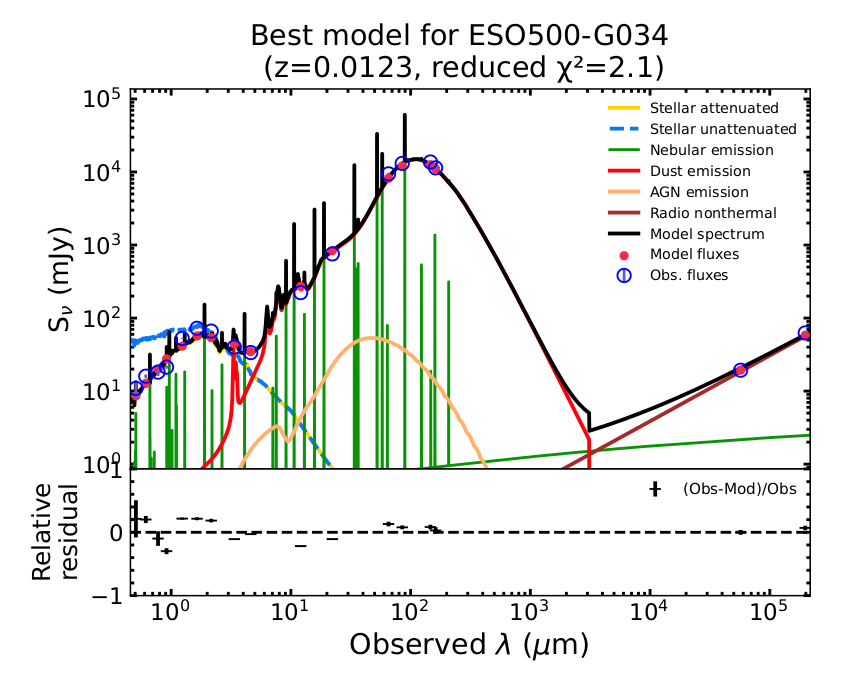Astronomy Object of the Month: 2022, September
< previous Archive next >
Investigating the mysterious Luminous infrared galaxies
In the 1980s when Infrared Astronomical Satellite (IRAS) was scanning the sky, it came across a few bright sources in the Infrared wavelength, which
were too faint to be detected in previous optical surveys. These galaxies were classified as Infrared galaxies.
Luminous Infrared galaxies (LIRGs), as the name suggests, are
characterized by a prodigious amount of emission at infrared (IR) wavebands (LIR > 1011 L☉). The bulk infrared emission
in these galaxies is due to warm dust heated by active galactic nuclei, starbursts, or both. These galaxies hence provide a unique laboratory to do a
comprehensive study of star
formation and AGN activity.

Illustration: 610 MHz radio contour images (red) from GMRT array overlaid on the optical PanSTARR
g-band image of galaxy ESO500-G034.
The spectral energy distribution (SED), although dominated by infrared emission, stretches from X-ray to radio wavebands. It is the outcome of the complex physical interplay between their main baryonic components such as stars of all ages and their remnants; molecular, atomic, and ionized gas; dust; and supermassive black holes. The panchromatic SED of a galaxy contains the imprint of these baryonic processes that drive its formation and evolution along cosmic times. Comparing the SEDs at different emission wavebands provide key insight into the origin and nature of emission and the factors setting their energy balance.
With this motivation, we performed a SED modelling of radio-only and far-ultraviolet (FUV) to radio bands of a sample of 11 local LIRGs, including our new measurements at 325 and 610 MHz frequencies using the Giant Metrewave Radio Telescope. In our work, we report the results of detailed radio SED modelling covering ~80 MHz to ~15 GHz and UV-radio SED modeling conducted using Code Investigating GALaxy Emission CIGALE.
Integrated radio SEDs are modelled with physically motivated scenarios in which the radio continuum originates from either single or two emission regions characterized by the same or different populations of cosmic-ray electrons and optical depths. Hence, radio-only SED modelling show complex shapes with multiple turnovers for some galaxies (Fig. 1) instead of the simple power-law.

Figure 1. Radio SED of galaxy IR18293-3413. Credit: The Authors.

Figure 2. FUV-Radio SED of galaxy IR18293-3413. Credit: The Authors.

Figure 3. Comparison of the SFRIR obtained for two-time intervals: 10 and 100 Myr ago
from the CIGALE SED fitting and the 1.4 GHz radio star formation rate (total, nonthermal, and thermal, respectively). Credit: The Authors.
One of the primary goals of this paper is to compare the astrophysical properties resulting from SED modelling at radio-only and FUV to radio bands. The shapes of SEDs reflect the radiation laws and their parameters (such as power-law energy index or emissivity) and the physical processes affecting those parameters, such as cooling or heating mechanisms in the medium. Moreover, integrated SEDs provide total energetics from different frequency regimes, and comparing those offers key information on the nature of emission and general factors that determine their energy balance. In this study, we performed SED modelling where model parameters are estimated using state-of-the-art Bayesian (radio-only) and Bayesian-like (CIGALE modelling) inference techniques. The radio-only SED modelling allowed us to decompose non-thermal and thermal radio components while the CIGALE modelling allowed us to fit complex star formation history models, i.e., delayed star formation with an exponential burst (in our case), enabling us to estimate star formation rate at the infrared wavelengt (SFRIR) at different time intervals.
A striking result is that we obtain a much better correspondence of radio emission (total and synchrotron) with the young stellar population of about 10 Myr than with the older population (Fig. 3). This is probably due to the relatively short lifetime of the synchrotron cosmic-ray electrons at the 1.4 GHz frequency. At this frequency, in a magnetic field of about 50 μG, the synchrotron lifetime is ~3.3x105 years. Therefore, synchrotron emission may be an effective indicator of recent star formation rates in galaxies. Our analysis strengthens that 1.4 GHz radio SFR measurements can be used as a diagnostic tool for high-z galaxies.
Original publication: Subhrata Dey, Arti Goyal, Katarzyna Małek, Timothy J. Galvin, Nicholas Seymour, Tanio Díaz Santos, Julia Piotrowska, Vassilis Charmandaris, Low frequency radio continuum imaging and SED modeling of 11 LIRGs: radio-only and FUV to radio bands. The article has been accepted for publication in ApJ.
The research was conducted at the Departments of High Energy Astrophysics and Radioastronomy and Space Physics of the Jagiellonian University’s Astronomical Observatory (OA UJ). The work was carried out thanks to the financial support of the National Science Center through grant 2018/29/B/ST9/02298 and Jagiellonian University through grant N17/MNS/000014.
This work was presented in the Coimbra group's 3-minute thesis presentation. Subhrata Dey received second prize and the Audience Award for her presentation Investigating the mysterious Luminous infrared Galaxies.

|
Subhrata Dey Astronomical Observatory Jagiellonian University S.Dey [@] oa.uj.edu.pl |
Dr. hab Arti Goyal Astronomical Observatory Jagiellonian University Arti.Goyal [@] uj.edu.pl |


